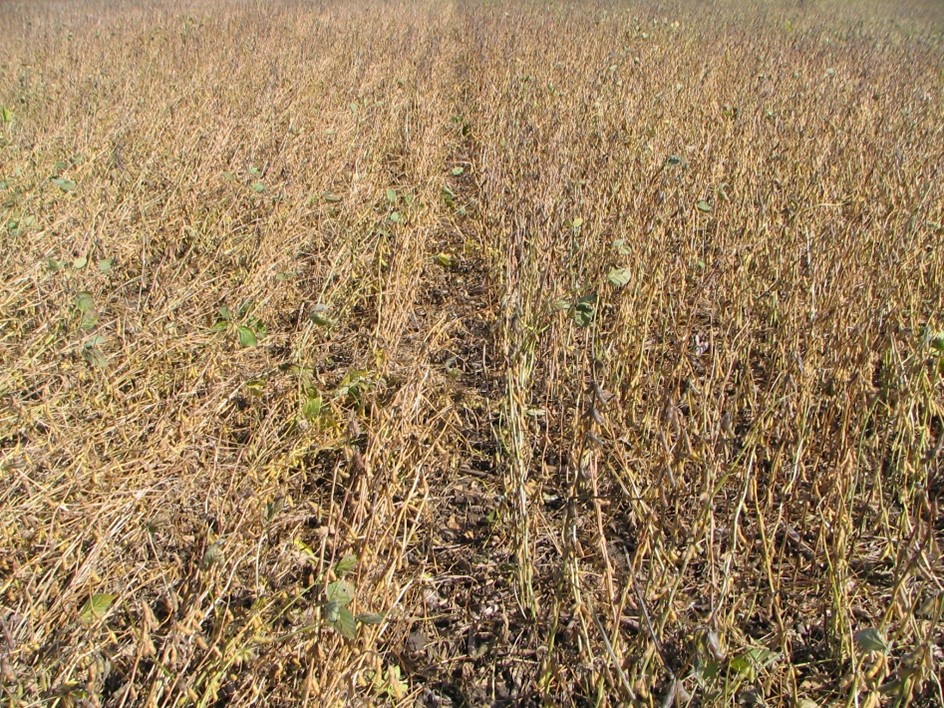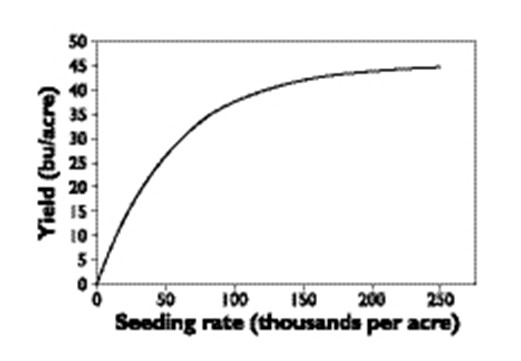Soybeans yield well over a wide range of seeding rates and final plant stands. Soybeans will compensate for thin stands, assuming weather conditions allow for strong growth. Higher plants stands are necessary in shorter season areas and clay soils compared to southern regions with lush growing environments. Excessive seeding rates add unnecessary cost and increase the risk of lodging and diseases, see figure 2.

Figure 1. On the left, a seeding rate of 250,000 seeds/acre resulted in lodging. On the right, a seeding rate of 200,000 seeds/acre did not result in lodging.
As demonstrated in Figure 2, Soybean Yield Response to Seeding Rates, there is no significant yield advantage to seeding rates greater than 494,000 seeds/ha (200,000 seeds/acre) on most soil types. Figure 1 is based on data from 45 Ontario trials in 38 cm (7.5 in.) rows.

Figure 2. Soybean Yield Response to Seeding Rates.
Table 1, Soybean Seeding Rate Guidelines, contains a list of recommended seeding rates. Soybeans should be planted based on seeds/ha (seeds/ac), not simply bu seeds/ha (seeds/ac).Seeding rate requirements decrease as row width increases. These seeding rates are adequate for both conventional and no-till production. When utilizing precision seeding equipment instead of seed drills, rates can be reduced by at approximately 5%. A seed treatment can further reduce seeding rates requirements by 5%. An emergence rate of about 75-85% is considered normal in soybeans. (90% germination X 90% emergence = 81% final stand) Full yield potential is achieved with final plant stands between 272,000-370,000 plants/ha (110,000-150,000 plants/acre), depending on row width. More plants per acre are required on heavy clay soils, particularly in dry years or when planting late. Seeding rates must be increased for seed with a lower germination rating or for soils prone to crusting. Some producers are successful with seeding rates as low as 130,000 seeds/acre in intermediate row widths and even lower rates in 76 cm (30 in.) rows, in fields that produce large plants. Establishing a specific number of plants per hectare (acre) is the aim of seeding. Good management practices and weather conditions after seeding have a large impact on final plant stands. Good planting equipment, high seed quality, and seed treatments are key factors to consider when using lower seeding rates to achieve adequate stands.
Table 1. Soybean Seeding Rate Guidelines
| These seeding rates are based on having a germination of 90% and an emergence of 90% (plant stand of 81% of seeding rate). | ||||
| Seed Size | Row Width | |||
| 19 cm (7.5 in.) row 480,000 seeds/ha (194,000 seeds/acre) 9 seeds/m of row (2.8 seeds/ft of row) | 38 cm (15 in.) row 437,000 seeds/ha (177,000 seeds/acre) 17 seeds/m of row (5.1 seeds/ft of row) | 56 cm (22 in.) row 425,000 seeds/ha (172,000 seeds/acre) 24 seeds/m of row (7.2 seeds/ft of row) | 76 cm (30 in.) row 400,000 seeds/ha (162,000 seeds/acre) 30 seeds/m of row (9.3 seeds/ft of row) | |
| 4,400 seeds/kg (2,000 seeds/lb) | 109 kg/ha (97 lb/acre) | 99 kg/ha (89 lb/acre) | 98 kg/ha (86 lb/acre) | 91 kg/ha (81 lb/acre) |
| 4,900 seeds/kg (2,200 seeds/lb) | 98 kg/ha (88 lb/acre) | 89 kg/ha (80 lb/acre) | 88 kg/ha (79 lb/acre) | 82 kg/ha (74 lb/acre) |
| 5,300 seeds/kg (2,400 seeds/lb) | 91 kg/ha (81 lb/acre) | 82 kg/ha (74 lb/acre) | 82 kg/ha (74 lb/acre) | 76 kg/ha (68 lb/acre) |
| 5,700 seeds/kg (2,600 seeds/lb) | 84 kg/ha (75 lb/acre) | 77 kg/ha (68 lb/acre) | 76 kg/ha (66 lb/acre) | 70 kg/ha (63 lb/acre) |
| 6,200 seeds/kg (2,800 seeds/lb) | 77 kg/ha (69 lb/acre) | 70 kg/ha (63 lb/acre) | 70 kg/ha (63 lb/acre) | 65 kg/ha (58 lb/acre) |
| 6,600 seeds/kg (3,000 seeds/lb) | 73 kg/ha (65 lb/acre) | 66 kg/ha (59 lb/acre) | 65 kg/ha (58 lb/acre) | 61 kg/ha (54 lb/acre) |
| 7,100 seeds/kg (3,200 seeds/lb) | 68 kg/ha (61 lb/acre) | 62 kg/ha (55 lb/acre) | 61 kg/ha (54 lb/acre) | 57 kg/ha (51 lb/acre) |
| 7,500 seeds/kg (3,400 seeds/lb) | 64 kg/ha (57 lb/acres) | 58 kg/ha (52 lb/acre) | 58 kg/ha (51 lb/acre) | 53 kg/ha (48 lb/acre) |
When calibrating seed drills or determining plant stands it can be helpful to know the number of seeds or plants per foot of row necessary for a certain population. To determine the seeds needed per foot of row:

Example:

Example:

Special consideration should be given to fields prone to white mould. To minimize disease severity, the main tools are variety selection, wider rows, no-till and lower plant populations. Although wide rows and lower seeding rates will result in yield loss in those years when conditions do not favour white mould, this approach can significantly reduce white mould severity during wetter summers. Fields prone to white mould should be planted with a minimum row width of 38 cm (15 in.) at 370,000 seeds/ha (150,000 seeds/acre). Use 76 cm (30 in.) rows in fields where white mould infestations have been severe in the past.
When late-planting into mid-June, increase planting rates by 10%.
Seed Treatments
Soybean seed treatments have been shown to increase plant stands and improve yields. In no-till, clay-soils, or early planted fields, they have been an important tool to establish a uniform plant stand. The weather after seeding, as well as the amount of disease and insect pressure, affect stand and yield responses. Table 3, Soybean Plant Stand and Yield Response to Seed Treatments, shows average Ontario results based on 35 field trial. When conditions were favourable for rapid emergence and little insect or disease pressure was evident, no yield benefit was found in soybean seed treatments.
Table 2. Soybean Plant Stand and Yield Response to Seed Treatments
| Response | Control | Fungicide + Insecticide |
| Population1 | 307,000 plants/ha (124,000 plants/acre) | 321,000 plants/ha (130,000 plants/acre) |
| Yield | 3.3 t/ha (49.4 bu/acre) | 3.4 t/ha (51.1 bu/acre) |
| 1Plant stands taken at 30 days after seeding. Source: Hooker, U of G. | ||